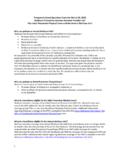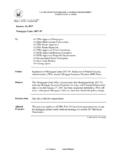Transcription of REGIONAL AND STATE UNEMPLOYMENT—2018 ANNUAL …
1 For release 10:00 (EST) Tuesday, February 27, 2018 USDL-18-0297 Technical information: (202) 691-6392 Media contact: (202) 691-5902 REGIONAL AND STATE unemployment 2017 ANNUAL AVERAGES In 2017, ANNUAL average unemployment rates decreased in 32 states and were little changed or unchanged in 18 states and the District of Columbia, the Bureau of Labor Statistics reported today. Employment-population ratios increased in 12 states , decreased in 2 states , and were little changed or unchanged in 36 states and the District. The jobless rate declined by percentage point from the prior year to percent, and the national employment-population ratio rose by point to percent. REGIONAL unemployment All four census regions had unemployment rate decreases from 2016: the Midwest, South, and West ( percentage point each) and the Northeast ( point).
2 The Midwest had the lowest jobless rate, percent in 2017. No other region had a rate significantly different from that of the The West recorded the lowest unemployment rate in its series, percent. (All region, division, and STATE series begin in 1976. See table 1.) All nine geographic divisions had over-the-year unemployment rate declines in 2017. The largest of these occurred in the East South Central ( percentage point). The lowest jobless rate was in the West North Central, percent, followed by the New England and Mountain divisions ( percent and percent, respectively). The highest rates were in the Middle Atlantic and Pacific ( percent each). The remaining four divisions had rates that were not significantly different from that of the The Pacific recorded the lowest unemployment rate in its series, percent.
3 Changes to Local Area unemployment Statistics Data Effective with this news release, the civilian labor force and unemployment data for census regions and divisions, the states and the District of Columbia, and the modeled substate areas were revised to incorporate updated inputs, new population controls, reestimation of models, and adjustment to new control totals. In addition, a new procedure for seasonally adjusting the data was implemented. While the not seasonally adjusted data were revised from 2013 forward, the seasonally adjusted data were revised back to 1976. Information on the new seasonal adjustment procedure is available at -2- STATE unemployment Thirty-two states had statistically significant unemployment rate decreases in 2017. The largest decline occurred in Alabama ( percentage points), followed by Wyoming ( points) and Tennessee ( point).
4 The remaining 18 states and the District of Columbia had ANNUAL average jobless rates in 2017 that were not appreciably different from those of the previous year, though some had changes that were at least as large numerically as the significant changes. (See table A and map 1.) Hawaii and North Dakota had the lowest unemployment rates in 2017, percent and percent, respectively. Alaska had the highest jobless rate, percent, followed by New Mexico, percent. The District of Columbia had a rate of percent. Overall, 20 states had unemployment rates significantly lower than the figure of percent, 12 states and the District had higher rates , and 18 states had rates that were not appreciably different from that of the nation. Seven states recorded the lowest unemployment rates in their series in 2017: Arkansas ( percent), California ( percent), Hawaii ( percent), Maine ( percent), North Dakota ( percent), Oregon ( percent), and Tennessee ( percent).
5 (See table B and map 2.) REGIONAL Employment-Population Ratios In 2017, two census regions had statistically significant changes in their employment-population ratios the proportion of the civilian noninstitutional population 16 years of age and over who are employed both of which were increases. These occurred in the West (+ percentage point) and South (+ point). The Midwest had the highest ratio, percent, while the South, at percent, had the lowest. These two regions had the only ratios that were notably different from the national figure of percent. (See table 2.) Four of the 9 geographic divisions had increases in their employment-population ratios from 2016 to 2017: the East South Central and South Atlantic (+ percentage point each) and the Mountain and Pacific (+ point each).
6 The remaining five divisions experienced little or no change in their ratios. The division with the highest employment-population ratio in 2017 was the West North Central, percent, followed by New England, percent. These two divisions, along with the Mountain and East North Central, at percent and percent, respectively, had employment-population ratios significantly above that of the The East South Central had the lowest proportion of employed persons, percent. The ratios in the Middle Atlantic ( percent) and South Atlantic ( percent) also were appreciably below the national average. STATE Employment-Population Ratios In 2017, the largest employment-population ratio increase among the states occurred in Colorado (+ percentage points), followed by Georgia and Tennessee (+ points each).
7 Nine other states also had significant increases in their ratios. Two states had over-the-year decreases in their employment-population ratios: Nebraska ( percentage point) and New Hampshire ( point). The remaining 36 states and the District of Columbia had ratios that were not appreciably different from those of the previous year, though some had changes that were at least as large numerically as the significant changes. (See table C.) -3- North Dakota had the highest proportion of employed persons, percent in 2017. The next highest ratios were in Minnesota, percent, and Utah, percent. West Virginia had the lowest employment-population ratio among the states , percent. (West Virginia has had the lowest employment-population ratio each year since the series began in 1976.)
8 Overall, 24 states and the District of Columbia had employment-population ratios significantly higher than the ratio of percent and 16 states had ratios that were below it. Alaska had the lowest employment-population ratio in its series, percent. (See table D and map 3.) _____ The STATE Employment and unemployment news release for January 2018 is scheduled to be released on Monday, March 12, 2018, at 10:00 (EDT). The Metropolitan Area Employment and unemployment news release for January 2018 is scheduled to be released on Friday, March 16, 2018, at 10:00 (EDT). -4- Table A. states with statistically significant unemployment rate changes, 2016 17annual averages20162017 Alabama .. Mexico .. Carolina .. Dakota .. Island .. Carolina .. Virginia.
9 Rate change -5- StateRate United states .. of Columbia .. Hampshire .. Mexico .. York .. Dakota .. Dakota .. Virginia .. the , 2017 ANNUAL averagesTable B. states with unemployment rates significantly different from that-6- Table C. states with statistically significant employment-population ratio changes,2016 17 ANNUAL averages20162017 Alabama .. Hampshire .. ratio change -7- StateRatio United states .. of Columbia .. Hampshire .. Mexico .. York .. Carolina .. Dakota .. Island .. Carolina .. Dakota .. Virginia .. that of the , 2017 ANNUAL averagesTable D. states with employment-population ratios significantly different Technical Note This release presents labor force and unemployment data for census regions and divisions and states from the Local Area unemployment Statistics (LAUS) program.
10 The LAUS program is a federal- STATE cooperative endeavor. Concepts Definitions. The labor force and unemployment data are based on the same concepts and definitions as those used for the official national estimates obtained from the Current Population Survey (CPS), a sample survey of households that is conducted for the Bureau of Labor Statistics (BLS) by the Census Bureau. The LAUS program measures employed and unemployed persons on a place-of-residence basis. The universe for each is the civilian noninstitutional population 16 years of age and older. Employed persons are those who did any work at all for pay or profit in the reference week (the week including the 12th of the month) or worked 15 hours or more without pay in a family business or farm, plus those not working who had a job from which they were temporarily absent, whether or not paid, for such reasons as labor management dispute, illness, or vacation.















